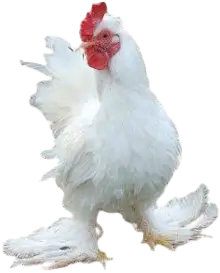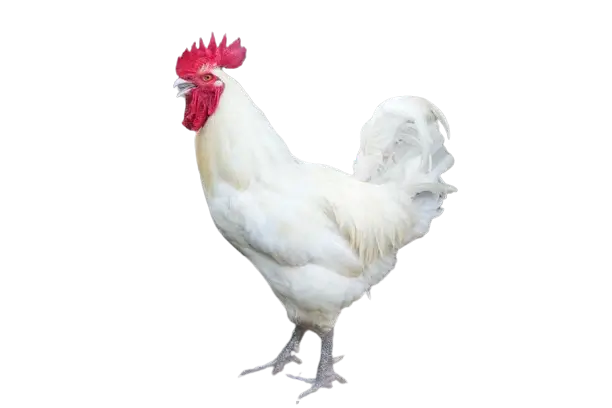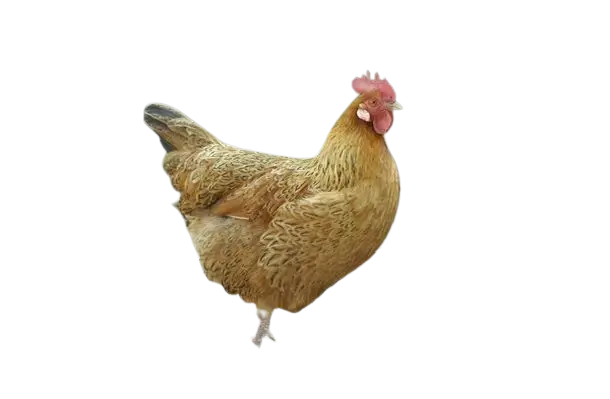Burmese chicken

Burmese chickens have a fascinating history. Charles Darwin originally mentioned them in his book The Variation of Animals and Plants Under Domestication 1868. According to Darwin, a British Army officer brought them to the UK from Burma in the 1880s. William Flamank Entwisle, a poultry breeder, received one of these birds with a genetic mutation that caused short legs and feathered feet. He used this bird to create the Burmese chicken breed with a small crest and a single comb.
However, the Burmese breed was believed to be extinct by the beginning of the First World War. It was not until 1970 that some surviving individuals were discovered by Andrew Sheppy, who founded the Rare Poultry Society. He bred them with white-booted Bantams, another breed with feathered feet, to re-establish the Burmese breed. Since then, the Poultry Club of Great Britain and the Rare Poultry Society have recognized the Burmese breed.
Types
Burmese chickens are a type of bantam chicken, which means they are smaller than standard-sized chickens. They have developed bantams derived from larger breeds, such as the Booted Bantam and the Sultan. However, they have unique features like the crest, short legs, and a single comb.
Colors
Burmese chickens come in only one color: white. This is the only color recognized by the Poultry Club of Great Britain and the Rare Poultry Society.
Weight of male and female
Burmese chickens are small, light birds weighing less than half a kilogram. According to the British Poultry Standards, the ideal weight for a male Burmese chicken is 570 g, and for a female Burmese chicken is 450 g. These weights are similar to those of other Bantam breeds, such as the Booted Bantam, the Japanese Bantam, and the Serama.
Annual egg production rate, egg color, and egg weight
Burmese chickens are not known for their high egg production. They typically lay around 80 to 100 eggs annually, which is lower than the average for bantam breeds that lay around 150 to 200. However, this is unsurprising since Burmese chickens are ornamental and not bred for egg production.
The eggs of Burmese chickens are small, white, and weigh about 30 to 35 grams. They are oval-shaped with a smooth, glossy shell.
Burmese chicken Size
Burmese chickens are short and compact birds with low and horizontal postures. According to the British Poultry Standards, the ideal length for a male Burmese chicken is 25 cm, and for a female Burmese chicken is 23 cm, measured from the tip of the beak to the end of the tail. The ideal height for a male Burmese chicken is 18 cm, and for a female Burmese chicken is 16 cm, measured from the ground to the top of the head.
Burmese chickens have short legs due to a genetic mutation called the creeper gene. This gene causes the legs to be shorter than normal and the feet to be feathered. This gives the Burmese chickens a distinctive and attractive appearance and limits their mobility and agility.
Yearly Birth Rate and Life Span of Burmese Chicken
Burmese chickens lay around three to four eggs weekly. After 21 days of incubation, the chicks hatch and become fully feathered at six weeks. Burmese chickens have a relatively long lifespan, averaging around seven to eight years. Proper care and protection from predators and diseases can help them live up to 10 years or more.
Breeding hints and tips
If you’re interested in breeding Burmese chickens, there are a few things you need to keep in mind. For instance, it’s essential to select healthy and purebred chickens and provide them with a clean, spacious coop that is adequately ventilated, lit, and bedded. It’s also important to supplement their diet with calcium and protein during the laying and hatching periods. You should monitor them for signs of mating behavior, such as courtship, mounting, and crowing. Burmese chickens typically mate from spring to autumn but can mate all year round in warmer climates.
To successfully breed Burmese chickens, you should collect the eggs daily, store them in a cool and dry place, and incubate them under a broody hen or in an artificial incubator. After 21 days of incubation, the eggs will hatch, and you should provide a warm and safe brooder for the chicks. Socialize the chicks early on, handle them gently and frequently, and keep them away from drafts and dampness.
General Characteristics
Burmese chickens have several unique qualities, making them an excellent choice for backyard flocks. They have a low and horizontal carriage and a graceful and dignified demeanor that gives them an elegant appearance. They are also friendly and docile and enjoy human company and attention. Burmese chickens are relatively hardy birds that can tolerate a range of climates and conditions. They lay about 80 to 100 small white eggs annually, which are tasty and nutritious but not enough for commercial use. While they are unsuitable for meat production, they can provide some eggs and meat for personal consumption or hatching and breeding.






